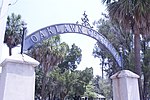North Franklin Street Historic District
Hillsborough County, Florida Registered Historic Place stubsHistoric districts on the National Register of Historic Places in FloridaNRHP infobox with nocatNational Register of Historic Places in Tampa, Florida

The North Franklin Street Historic District is a U.S. historic district (designated as such on March 28, 2002) located in Tampa, Florida. The district is bounded by Florida Avenue, East Fortune, Tampa, Franklin and East Harrison Streets. It contains 8 historic buildings.
Excerpt from the Wikipedia article North Franklin Street Historic District (License: CC BY-SA 3.0, Authors, Images).North Franklin Street Historic District
North Franklin Street, Tampa Tampa Heights
Geographical coordinates (GPS) Address Nearby Places Show on map
Geographical coordinates (GPS)
| Latitude | Longitude |
|---|---|
| N 27.954166666667 ° | E -82.460277777778 ° |
Address
Mole y Abuela
North Franklin Street 1202
33602 Tampa, Tampa Heights
Florida, United States
Open on Google Maps










